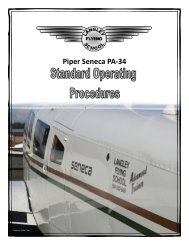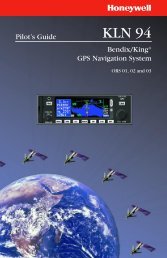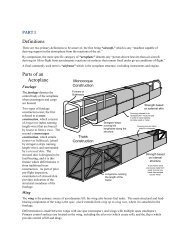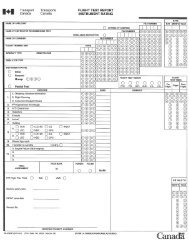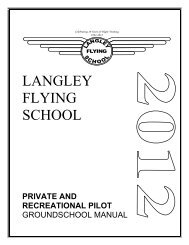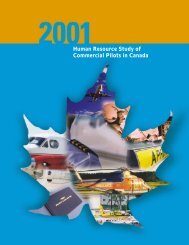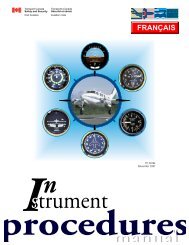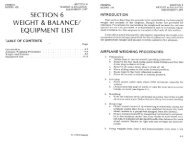LANGLEY FLYING SCHOOL Flight Training Handbook
LANGLEY FLYING SCHOOL Flight Training Handbook
LANGLEY FLYING SCHOOL Flight Training Handbook
Create successful ePaper yourself
Turn your PDF publications into a flip-book with our unique Google optimized e-Paper software.
<strong>Flight</strong> <strong>Training</strong> <strong>Handbook</strong> Page 12<br />
Langley Flying School, Inc.<br />
INTRODUCTION<br />
This <strong>Handbook</strong> is designed for both initial and advanced training. I remember how exciting (and often confusing) it<br />
was for me when I started flight lessons. For most who learn to fly, it is a brand-new experience, and there is a<br />
wealth of information that you will eventually come to terms with. For commercial students, the focus of training is<br />
on instrument flight procedures, yet only a small percentage of the flight test concerns instrument flying; the rest of<br />
the flight test is a display of flying exercises outlined in this manual—skills and knowledge originally learned during<br />
private pilot training. Accordingly, for both initial and advance training this manual provides what we regard as<br />
crucial information associated with individual flight lessons and manoeuvres. Essentially, the material is born from<br />
a collection of notes that I developed for myself during my Instructor training. The notes quickly turned into<br />
handouts, primarily so those students would not have to take notes during briefings and could instead concentrate on<br />
listening. This manual is an amalgamation of those handouts.<br />
I will take this opportunity to thank the many people who have contributed to my own understanding of flying, and<br />
those who have contributed to that collection of Instructors and Students that is called Langley Flying School.<br />
Going back to the late 1970s, I am personally indebted to Professors A. Olmsted, D. Hatt, and A. Heinrich (they<br />
should all be full Professors by now!), who make great effort to implant curiosity into the minds of their young<br />
undergraduate students. I am also personally indebted to the many instructors I have had the pleasure of working<br />
with in my role as “student”—which of course for any good instructor is a never-ending role—Lenora Crane,<br />
Gordon Jones, Mac Arbuthnot, Paul Tinevez, Mark Adam, Jim Krause, Wayne Wolshyn, Jo Harris, Heather Baile,<br />
Jamie Roth, John Laing, Donn Richardson, Matt Edwards, Peter Shewring, Roy Isreal, John Milligan, Robert E.<br />
Leroux, Jim Dunn and Al Balogh. With respect to aircraft maintenance engineering and airworthiness, I am grateful<br />
to the efforts and assistance over the years by Don and Loraine Nikkel of Valley Aero Engines Ltd., and Joel H.<br />
Schoenberger, Wendy Boyes, and Simon Mears of Transport Canada’s Aircraft Maintenance and Manufacturing.<br />
Langley Flying School is but a mere collection of dedicated and hardworking individuals who, motivated by the<br />
love of flying (surely not of money!), have spent many hours contributing to the system of flight training operations<br />
that has evolved over the years—Kevin Williams, Michel Rouch, Sheldon Pohl (now a Boeing 737 Pilot with<br />
Westjet), Heather Wolf (now Boeing 747 Pilot with EVA Airways), Jarrod Burgess (now corporate jet pilot in<br />
Oklahoma), Nick van Empel (now an Air Canada pilot), Ron Reynolds, Corey Dyer (now a King Air pilot, Dave<br />
Beales, Jessica Hamstra (now an Air Canada Jazz pilot), Rita Methorst, David Woollam (now a Twin Otter Captain<br />
in the Maldives), Bob Brown, Dave Page (now a Bearskin Airlines pilot), Tom Larkin, Brandon Dreyer (now a<br />
Boeing 727 pilot with Kelowna <strong>Flight</strong>craft), Adam O’Sullivan, Patrice Gagnon (now an Air Canada Jazz pilot),<br />
Adam Katagiri, Peter Waddington, Ben Orlowski (now a Beech 1900 Captain with Pacific Coastal Airlines), Ryan<br />
Gahan (also Beech 1900 Captain with Pacific Coastal Airlines , Cullen Worth (now a Twin Otter Captain with<br />
Kenn Borek Air), Philip Craig (a pilot with Pacific Coastal Airlines), Justin Chung (also now a Beech 1900 Captain<br />
with Pacific Coastal Airlines), Rod Giesbretcht (also a pilot with Pacific Coastal Airlines), Naomi Jones (also pilot<br />
with Pacific Coastal Airlines) , and Hoowan Nam, Nam Vu, Mayank Mittal, and Beda Grunder.<br />
I always say that teaching flying is a wonderful profession that is rich in excitement, satisfaction, success and<br />
challenge. It truly is an honour to teach people how to fly. The pleasures of the job, however, originate from hearts<br />
and minds of students. Pilot students are never forced to come to school, and it is wonderful to work with such a<br />
highly motivated bunch. For all who complete Pilot <strong>Training</strong>, this course will serve to be the first step in the<br />
wonderful adventure of flight that will last a lifetime—for some it will be the first step in an exciting and rewarding<br />
career. When I get into an aeroplane, I still have the same sense of excitement and anticipation that I had on my first<br />
flight lesson at High River Airport on January 15th, 1987. Sentiments such as these do not fade for pilots.<br />
Special thanks to my Mamoo, Elizabeth (Betty) Parry, for her career role as editing adviser, and Mother. The<br />
inspiration for the Field of Dreams originates from my Dad, Ken Parry (who can still grease a Twin on—if you<br />
show him where the runway is—just kidding Dad!)—I still can’t believe my Dad talked me into building a flying<br />
school!<br />
David Parry,<br />
Chief Flying Instructor<br />
2012 David L. Parry



